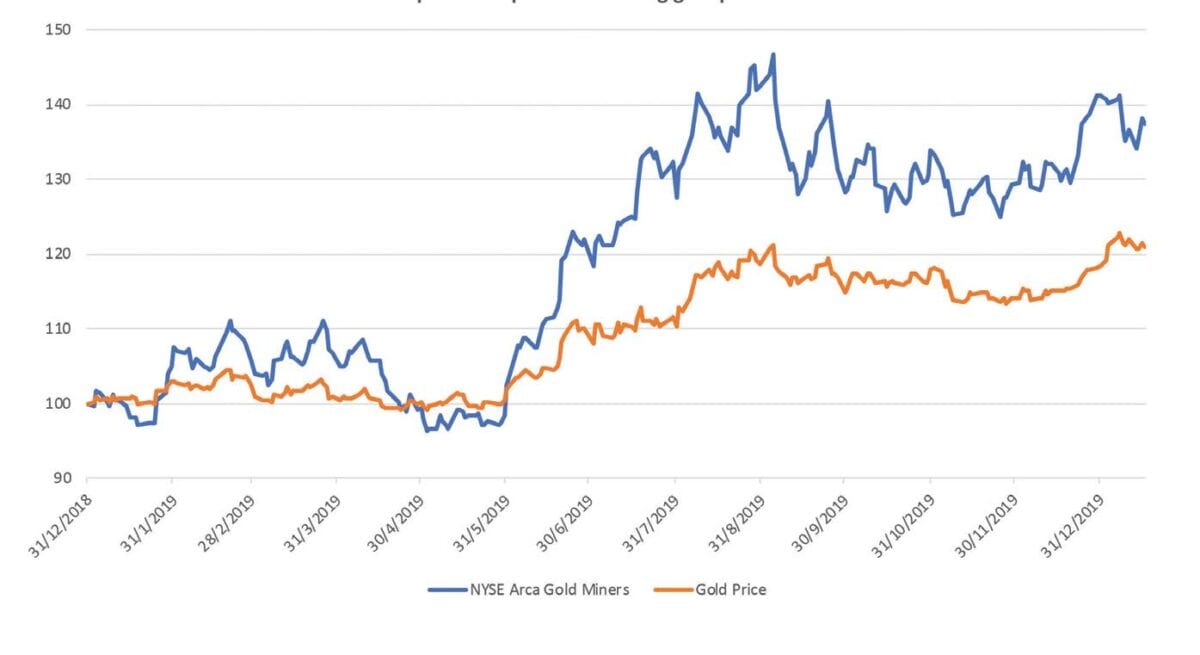The Investec Global Gold Fund has been running since late 1990. It invests primarily in gold mining equities, though the comparison index* includes some silver miners and we can invest up to 30% of the fund into other (non-precious metals) mining companies. It is an active fund and aims to generate long-term outperformance.
Currently we have just under 30 holdings, and all except two of them are precious-metals producing companies. The fund is weighted slightly towards mid/small cap companies (market capitalisation <$5bn), with 45% of our holdings in this category compared to 34% for the index.^ All the companies in the fund have a market capitalisation of at least US$500m, though we can invest in smaller companies, as we are keen to maintain good liquidity and prefer companies with positive cashflows that are in production (as opposed to just exploration).
Valuation is a key component of the process
We maintain models on around 80 companies and value them using three different metrics: return on capital employed (ROCE), multiples and discounted cash-flow (DCF). These three valuation points give us, in order, a medium, short and long term view of a company’s future prospects. We usually meet management teams more than once a year. We do not insist on a site visit, but try to visit countries/regions where we have not been before to understand if there any peculiar dynamics. That said, site visits are often a useful reminder of how hard operating mines can be.
Understanding management’s response to ESG risks is revealing
As important is our assessment of each company’s environmental, social and governance (ESG) performance. Investors are, rightly, focusing on the sustainability of companies across all sectors. We have assessed ESG factors as part of our process for a long time, but in recent years we have increased our engagement with companies in these areas. Comparing companies and management teams on their responses has been very revealing.
Gold Equities outperformed rising gold price in 2019

For example, last year we wrote to the companies in our portfolio asking that they look at reporting not only Scope 1 and 2 emissions, but also Scope 3. Put simply, Scope 1 and 2 emissions are the greenhouse gases directly associated with a company’s operations; Scope 3 emissions are the greenhouse gases outside of those direct emissions, including downstream and in the use of a product. The reasons we gave were:
1. Reporting the carbon emissions from ‘use of sold products’ allows investors to understand the climate risk associated with a company’s goods. Scope 3 emissions are likely to be small for gold producers, but it is important the gold sector moves forward with other global sectors in improving disclosure of Scope 3.
2. By not reporting Scope 3, gold companies run the risk of generalist investors assuming the worst and automatically excluding them during their screening processes.
3. Only by understanding the full carbon footprint can accurate carbon reduction targets be set and environmental performance tracked over time.
Since all companies face the same challenge when it comes to reporting climate-related risks, the responses we received were helpful for comparing the quality of management teams more broadly. As active managers, we are always looking to pick companies that can outperform over a sustained period and a good management team is vital to this.
Generally, we received a positive response, with many companies looking to detail Scope 3 data in the coming year. However, the increasing complexity of what investors are asking for reinforces the need for some companies to seek scale. Discovering gold is less valuable than it once was, as developing and producing it in a sustainable manner has become more complex and risky.
Consolidation in the gold sector looks set to continue in 2020
The last two months of 2019 saw a flood of deals in the gold sector as a long-promised consolidation accelerated. At least nine deals were approved or proposed in the weeks up to Christmas. They were sparked by four non-core asset sales, two each by Barrick and Newmont.
This flurry of activity comes after gold equities have substantially underperformed gold prices since late 2007. Despite a rally for equities beginning in late 2015, a number of gold companies are still struggling to attract generalist investors due to their poor track records and relatively small size. Following the mergers of Barrick / Randgold and Newmont / Goldcorp a year ago, mid-cap companies — keen to bulk up — were waiting to see what assets would be disposed of. These disposals are now happening.
Size should not be the only reason for M&A activity. However, in the case of gold, the fact is that a number of single-asset companies have struggled to attract investors. Partly, that’s because a lack of diversification has led to problems for some of them, either due to operational or country issues. For generalist investors, these companies are often too illiquid and have too much specific risk. In addition, as investors focus more on cash returns as well as companies’ ESG performance, smaller companies are struggling to meet investor demand for better disclosure and reporting. Of course, as discounts widen for single-asset companies, they start to become more attractive as targets for larger companies, which can expect to see the discount narrow on acquisition.
Consequently, we believe this consolidation will continue through 2020 and present some interesting opportunities for active managers. At the same time, companies that can demonstrate superior performance in meeting ESG demands should continue to outperform, as they have a better chance to attract a broader range of generalist investors and passive funds that screen on ESG metrics.












